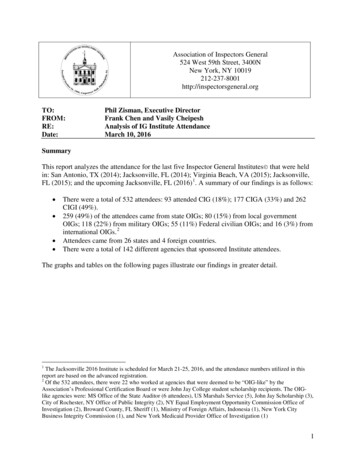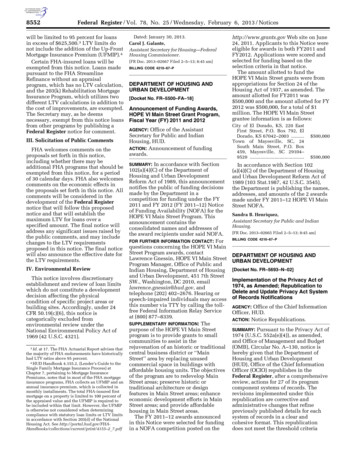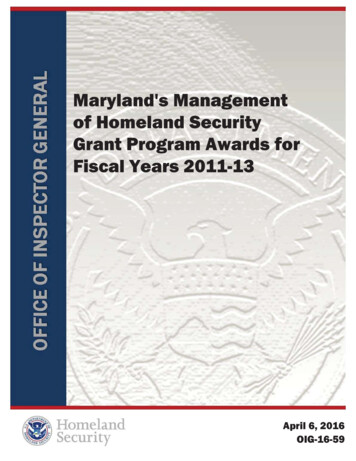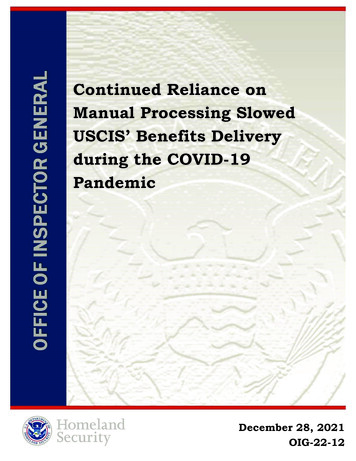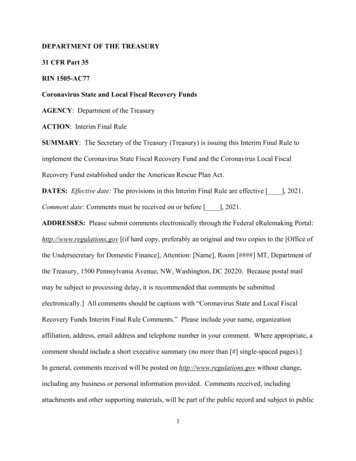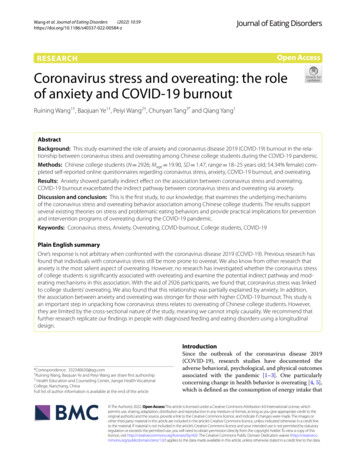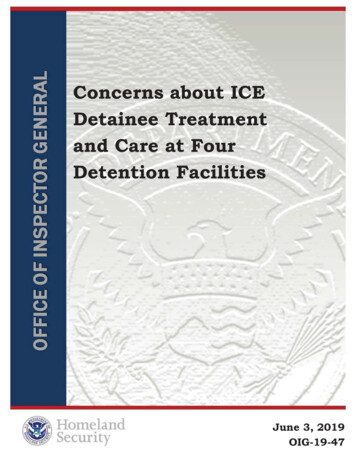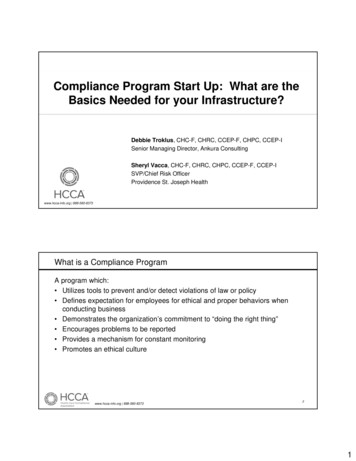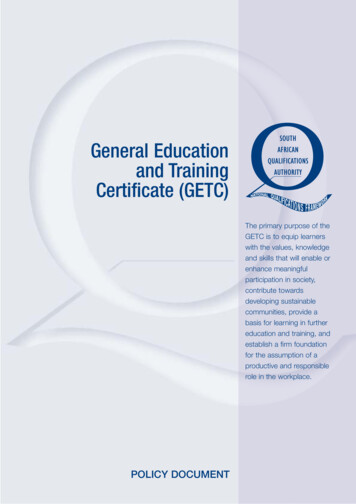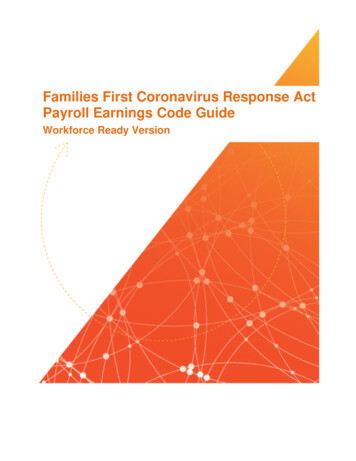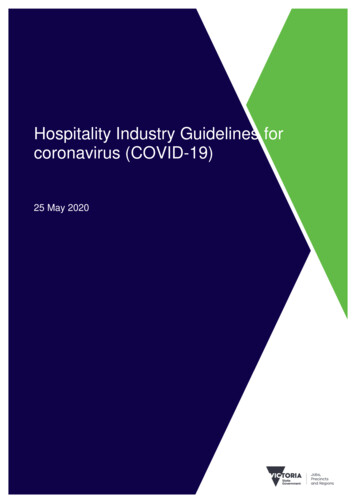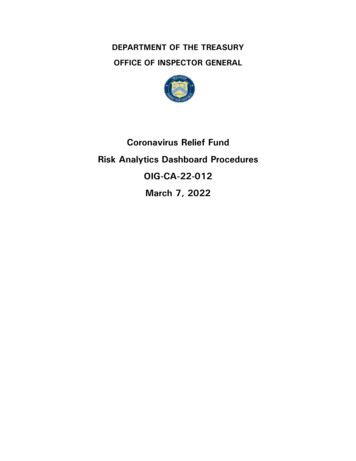
Transcription
DEPARTMENT OF THE TREASURYOFFICE OF INSPECTOR GENERALCoronavirus Relief FundRisk Analytics Dashboard ProceduresOIG-CA-22-012March 7, 2022
A. Coronavirus Relief Fund OverviewTitle VI of the Social Security Act, as amended by Title V of Division A ofthe Coronavirus Aid, Relief, and Economic Security Act 1 (CARES Act)established the Coronavirus Relief Fund (CRF) and appropriated 150 billion for making payments to States, Tribal governments, units oflocal government, the District of Columbia, and U.S. Territories. Paymentswere made in accordance with requirements outlined in Title V, of which 3 billion was reserved for payments to the District of Columbia and U.S.Territories and 8 billion was reserved for payments to Tribal governments.Further, no State received a payment of less than 1.25 billion. The CARESAct assigned the Department of the Treasury (Treasury) Office of InspectorGeneral (OIG) with responsibility for compliance monitoring and oversight ofthe receipt, disbursement, and use of CRF payments. Treasury OIG also wasassigned authority to recoup CRF proceeds in the event that it is determineda recipient of a CRF payment failed to comply with requirements ofsubsection 601(d) of the Social Security Act, as amended, (42 U.S.C.801(d)). The Consolidated Appropriations Act, 2021 2 extended the coveredperiod for recipients of CRF payments to use proceeds from March 1, 2020through December 31, 2021.The CARES Act stipulates that CRF recipients shall use the funds providedunder a payment made under Title V to cover only those costs that:(1) are necessary expenditures incurred due to the public health emergencywith respect to Coronavirus Disease 2019 (COVID-19);(2) were not accounted for in the budget most recently approved as ofMarch 27, 2020; and(3) were incurred between March 1, 2020 and December 31, 2021.B. Prime Recipient Reporting RequirementsBeginning in September, 2020, each Prime recipient was required to reportCOVID-19 related obligations and expenditures incurred during the coveredperiod, beginning March 1, 2020, and ending on December 31, 2021, asoutlined in the Coronavirus Relief Fund Reporting Requirements Update (OIGCA-20-025; July 31, 2020) 3. GrantSolutions, a grant and program123P.L. 116-136 (March 27,2020)P.L. 116-260 (December 27, 2020)The original prime recipient reporting requirements are contained in Coronavirus Relief FundReporting and Record Retention Requirements (OIG-CA-20-021; July 2, 1-01/OIG-CA-20-025.pdf.
management Federal shared service provider under the U.S. Department ofHealth and Human Services, developed a customized and user-friendlyreporting solution to capture the use of CRF payments. 4 The GrantSolutionsportal was prepopulated with prime recipient data to include CRF paymentamount(s), date(s), recipient Dun & Bradstreet unique identification number(DUNS number), 5 and contact information.On a quarterly basis, Treasury OIG’s CARES Act Monitoring Directoratereviews each prime recipient’s Financial Progress Report in GrantSolutionsfollowing the Coronavirus Relief Fund Prime Recipient QuarterlyGrantSolutions Submissions Monitoring and Review Procedures Guide (OIGCA-20-029R; April 19, 2021). The objective of the quarterly monitoring andreview is to monitor the progress of prime recipient reporting in the portaland determine whether direct follow up/outreach is needed; and for certifiedsubmissions, determine whether prime recipients’ submissions were timelysubmitted in accordance with the GrantSolutions portal instructions prior toTreasury OIG approval. Once the quarterly reviews are completed, theTreasury OIG approved Financial Progress Report is extracted fromGrantSolutions and sent to the Pandemic Response AccountabilityCommittee (PRAC) for publication on its website(www.pandemicoversight.gov) in accordance with Section 15010 of theCARES Act. 6C. CRF Risk Analytics Dashboard OverviewTreasury OIG worked with the PRAC to develop a risk scoring model toprioritize the risk associated with recipients of CRF payments at the prime456Prime recipients include all 50 States, units of local governments, the District of Columbia, U.S.Territories, and Tribal Governments that received a direct Coronavirus Relief Fund payment fromTreasury in accordance with the CARES Act.The Federal Government will stop using a DUNS number to uniquely identify entities on April 4,2022. Entities doing business with the Federal Government will begin using a Unique EntityIdentifier (UEI) generated in the System for Award Management (SAM.gov).Section 15010 of the CARES Act established the PRAC within the Council of Inspectors Generalon Integrity and Efficiency to promote transparency and conduct and support oversight ofcovered funds and the coronavirus response to (1) prevent and detect fraud, waste, abuse, andmismanagement; and (2) mitigate major risks that cut across program and agency boundaries.
recipient and subrecipient 7 levels. The risk scoring model is displayed in theCRF Risk Analytics Dashboard that will assist Treasury OIG in identifyingwhich prime recipients and subrecipients are at a higher risk for fraud,waste, abuse, and unallowable uses of CRF payments. High risk primerecipients and prime recipients with high risk subrecipients will be elevatedfor desk reviews and/or audits.PurposeThe purpose of the CRF Risk Analytics Dashboard procedures is to aidTreasury OIG in analyzing reporting deficiencies, data anomalies, andunallowable uses of CRF payments from the GrantSolutions portal identifiedby the (1) quarterly reviews monitoring/approval team, (2) desk reviewengagement team, and/or (3) data analytics team. In addition, the CRF RiskAnalytics Dashboard procedures will be used to select higher risk primerecipients and related subrecipients for audit or desk review. Procedures formonitoring, reviewing, and approving prime recipient’s quarterlyGrantSolutions submissions are documented separately in the CoronavirusRelief Fund: Prime Recipient Quarterly GrantSolutions SubmissionsMonitoring and Review Procedures Guide. Procedures for desk reviews of theprime recipient’s receipt, disbursements, and uses of CRF proceeds aredocumented separately in the Coronavirus Relief Fund: Prime Recipient DeskReview Procedures Guide (OIG-CA-21-004R; March 22, 2021).7Per the Department of the Treasury Office of Inspector General Coronavirus Relief FundFrequently Asked Questions Related to Reporting and Recordkeeping (Revised)(OIG-CA-20-028R;March 2, 2021) question 3: “Treasury has provided guidance on the applicability of Single Auditand 2 C.F.R. Part 200, Subpart F in response to question B.13 of its Coronavirus Relief FundFrequently Asked Questions (FAQs).6 According to Treasury’s FAQ, “the Single Audit Act and 2C.F.R. Part 200, Subpart F regarding audit requirements apply to any non-federal entity, asdefined in 2 C.F.R. 200.69, that receives payments from the Fund in the amount of 750,000 ormore. Non-federal entities include subrecipients of payments from the Fund, including recipientsof transfers from a State, territory, local government, or tribal government that received apayment directly from Treasury. However, sub-recipients would not include individuals andorganizations (e.g., businesses, non-profits, or educational institutions) that are beneficiaries ofan assistance program established using payments from the Fund. The Single Audit Act and 2C.F.R. Part 200, Subpart F regarding audit requirements do not apply to beneficiaries.” While theTreasury definition above is used for Single Audit Act purposes, Treasury OIG requires that theprime recipient report on both a beneficiary and a sub-recipient in the GrantSolutions portal.Since there is no separate category to capture a beneficiary’s data in the portal, the primerecipient must report on the beneficiary in the sub-recipient data fields. As such, forGrantSolutions reporting, a subrecipient/beneficiary is any entity to which a prime recipient issuesa contract, grant, loan, direct payment, or transfer to another government entity of 50,000 ormore.”
D. CRF Risk Analytics Dashboard ProceduresThe following procedures will be used by Treasury OIG to prioritize the riskassociated with entities receiving CRF funds at the prime and subrecipientlevel. These procedures are to be used at the discretion of the reviewer anddo not exclude other reviews and analysis of prime recipient data as deemedappropriate.CARES Act : CRF Risk Analytics Dashboard ProceduresObjective: To identify which prime recipients should be selected for deskreview and/or audit based on their risk scores and other known factors suchas complaints received or congressional interest.Pre-Assessment of Prime Recipients1. Access the Risk Score page on the CRF Risk Analytics BI Dashboard.The Risk Score page provides summary level data for prime andsubrecipients to include the PRAC entity ID, entity name, recipienttype, risk scores, and expenditures. It also includes functionality tosort, filter, and export data for additional analysis outside of theDashboard.2. On the Risk Score page, filter the “Prime or Sub” category to displayprime recipients only by selecting the “Prime Recipient” and “PrimeType” options.3. Analyze prime recipient data to identify prime recipients to be selectedfor desk review and/or audit. Data analysis may be performed withinthe Risk Score page. Alternatively, the data may be exported toMicrosoft Excel for analysis by selecting “More Options”, the three dotsicon located at the top right, and then selecting “Export data”.a. Coordinate with the CARES Act Monitoring Directorate AuditDirector or Audit Manager to determine which prime recipientshave desk reviews and/or audits in progress/completed. Primerecipients previously selected for a desk review and/or auditshould be removed from the population.4. The Risk Score page also identifies four risk scores that may beconsidered when prioritizing prime recipients for a desk review and/oraudit.
a. The risk composite score is the overall risk associated with primerecipients. The risk composite score includes the:i. Risk Indicator Score which determines how risk-prone anentity is. Twenty-seven risk metrics were consolidated into18 risk indicators, weighted by risk level, and used tocalculate the Risk Indicator Score;ii. Sub Propagation Score which determines how risk-prone aprime’s subrecipients are; andiii. Risk Amount Score which determines how much money isassociated with an entity.While the Composite Risk Score provides an overall gauge of risk,consider the impact of all risk scores along with the below riskmetrics/indicators and other reviews and analyses when determiningpriority of prime recipients for a desk review and/or audit.Priority of Prime Recipients Selected for Desk Review and/or Audit5. A desk review and/or audit will be performed on the following primerecipients with priority based on the risk composite score and otherknown factors including:a. All prime recipients whose risk indicator score is 100;b. All prime recipients who reported all of their obligation andexpenditure data in the aggregate in the GrantSolutions portal;c. All 50 states;d. All territories;e. Select local units of government whose risk composite score isat least 70 percent;f. Select tribal governments whose risk composite score is at least70 percent.g. Select prime recipients as a result of a CRF complaint; andh. Select prime recipients as a result of Congressional interest.Assessment of Selected Prime Recipient6. Drill through the selected prime recipient’s transaction page to analyzedetailed information about the recipient related to the following:a. Subrecipient countb. Transaction countc. Transaction amountd. Expenditure Amountse. Expenditure Categoriesf. Prime to Subrecipient transaction
7. Select the Entity Risk Summary tab to drill through risk indicatorsassociated with the selected prime recipient including the following:a. The subrecipient’s nameb. Amount of CRF awardedc. Risk scores associated with the primed. Entity address informatione. Risk flags triggeredAssessment of Selected Prime Recipient Risk Indicator Flags8. Individual risk details for risk flags may be analyzed by right clicking onthe entity’s name on the Risk Score page and selecting the ‘Options’drop down then “Drill Through” and “Entity Risk Summary”. Pay closeattention to the available options in the “Drill Through” menu and selectthe corresponding risk details pages for more information. Risk flags aresummarized and explained below.9. If Risk Indicator 1a, 1b, 1c, and/or 1d: Single Audit is populated, thenthe prime is matched to the Single Audit database from the FederalAudit Clearinghouse to identify prime recipients that were associatedwith any of following 4 issues within the past 3 years:a.b.c.d.Going Concern (1a)Material Weakness (1b)Reportable Condition (1c)Material Non Compliance (1d)The engagement team should review the single audit reports for internalcontrol or other deficiencies that may pose risk or impact the primerecipient’s uses of CRF proceeds.10. If Risk Indicator 2a, 2b - SAM Sensitive File is populated, prime and/orsubrecipients matched the SAM Sensitive File (containing sensitive dataelements that are not available in the public file) to identify entities thatwere associated with the following 2 issues:a. Federal Delinquent Debt flag (2a)b. Shared Bank Accounts (2b)The SAM Sensitive File includes data collected from prospective Federalawardees required for conducting business with the Government,annual representations and certifications, and identification of thoseparties excluded from receiving Federal contracts.
11. If Risk Indicator 3 –SAM Debarments is populated, the prime and/orsubrecipients matched to the publicly available SAM exclusionsdataset. Both suspension and debarment data is displayed where therewas a match on DUNS (not utilizing the DUNS connector table in thisiteration) or Name/State.The engagement team should determine if the prime recipient awardedcontracts to subrecipients who are suspended and/or debarred fromdoing business with the Government for a specified period of time. Ifselected for a desk review of audit, the engagement team shouldassess the prime’s efforts to provide oversight of the subrecipient’s useof CRF proceeds.12. If Risk Indicator 4 - FAPIIS Terminations is populated, prime and/orsubrecipients matched to the Federal Awardee Performance andIntegrity Information System (FAPIIS) that contains Federal contractorcriminal, civil, and administrative proceedings in connection withFederal awards; suspensions and debarments; administrativeagreements issued in lieu of suspension or debarment; nonresponsibility determinations; contract terminations for cause ordefault; and defective pricing determinations. If selected for a deskreview of audit, the engagement team should assess the prime’s effortsto provide oversight of the subrecipient’s use of CRF proceeds.13. If Risk Indicator 5 – Treasury OIG Hotline is populated, the prime and/orsubrecipients matched to the Treasury OIG Hotline data for hotlinecomplaints. The engagement team should coordinate with the Office ofInvestigation and the CARES Act II audit director for results of anyinvestigations and/or inquiries performed on the prime recipient.14. If Risk Indicator 6a, 6b – IRS Form 990 is populated, the prime and/orsubrecipients matched to the Internal Revenue Service Form 990dataset to identify entities that were associated with the following 2issues:a. Significant Diversion of Assets (6a)b. Excess Benefit Transactions (6b)A diversion of assets includes any unauthorized conversion or use ofthe organization's assets other than for the organization's authorizedpurposes, including but not limited to embezzlement or theft. Excessbenefit generally means the excess of the economic benefit receivedfrom the applicable organization over the consideration given (includingservices) by a disqualified person.
15. If Risk Indicator 7 - SBIR/STTR is populated, the prime and/orsubrecipient matched to the Small Business Innovation Research (SBIR)and Small Business Technology Transfer (STTR) programs to identifyentities that received SBIR/STTR funding.16. If Risk Indicator 8 - Multi-Dipping is populated, the prime and/orsubrecipient is matched to the COVID-19/pandemic programs extracton USAspending.gov.17. If Risk Indicator 9 - Circular Relationships is populated, prime andsubrecipient pairs where one entity serves as the other entity's primerecipient in some transactions, and in other transactions, the sameentity was the subrecipient to the other entity is identified.18. If Risk Indicator 10a, 10b - CMRA/PO Box Address is populated, theaddresses for all prime and subrecipients were analyzed to identify thefollowing 2 conditions:a. CMRA Address Match (10a) - Identify CRF entities whoseaddresses match with the Commercial Mail Receiving Agency(CMRA) private mailbox data set. CMRA is a private businessthat accepts mail from the Postal Service on behalf of thirdparties. A CMRA may also be known as a mail drop (e.g.,mailboxes at a UPS store).b. PO Box Address (10b) – Identifies CRF entities with a PO Boxaddress.19. If Risk Indicator 11 – Benford’s Law is populated, prime recipientswhose transactions differed significantly from what was expected wereflagged. Benford's Law describes the expected distribution of leadingdigits in many naturally occurring sets of numbers such as financialrecords. An entity is flagged if the total deviance score surpasses thedefined threshold score of 20.090, which represents the chi-squareddistribution cut point for .01 with 8 degrees of freedom.20. If Risk Indicator 12 – Duplicate Payments is populated, transactionswere identified as duplicate if they were disbursed from the same primeto the same subrecipient for the same expenditure category on thesame start date and for the same amount after excluding reversal pairs.21.If Risk Indicator 13 – Round Dollar Payments is populated, transactionswere identified that do not report exact cents. In this case, the risk isattributed to the subrecipient for not reporting exact expendituredetails.
22. If Risk Indicator 14 – Statistical Modeling is populated, transactionswere identified as high relative to transactions at similar time points,similar award descriptions, and that were disbursed by the same primerecipient. Factors are accounted for simultaneously using a statistical(mixed effects) model with a threshold of 3 standard deviations.23. If Risk Indicator 15 – Duplicate Address is populated, subrecipients thatshare the same full address are identified. This output also includessubrecipients that share the same PO Box.24.If Risk Indicator 16a, 16b, 16c, 16d: Expenditures are populated, thefollowing applies:a. Aggregate subrecipient expenditure percentage analysis (16a) identifies top 10% of prime recipients when ranked in terms ofpercent of award or obligated or expended that is disbursed toaggregate recipients and when ranked in terms of magnitude ofaward that is disbursed to aggregate recipientsb. Individual subrecipient expenditure percentage analysis (16b) identifies top 10% of prime recipients when ranked in terms ofpercent of award or obligated or expended that is disbursed toindividual recipients and when ranked in terms of magnitude ofaward that is disbursed to individual recipientsc. Small business assistance expenditure (16c) – identifies top 10%of prime recipients when ranked in terms of percent of award orobligated or expended that is disbursed to subrecipients for“small business assistance” expenditure category and whenranked in terms of magnitude of award that is disbursed for the“small business assistance” expenditure categoryd. "Items not listed above" expenditure ratio (16d) – identifies top10% of prime recipients when ranked in terms of percent ofaward or obligated or expended that is disbursed to subrecipientsfor “Items Not Listed Above” expenditure category and whenranked in terms of magnitude of award that is disbursed for the“Items Not Listed Above” expenditure category25.If Risk Indicator 17 - Foreign Address is populated, prime and/orsubrecipients were identified where the country is not the "US". Threecountry code fields were used:a. Sub-country codeb. Primary place of performance country codec. Recipient country code
26. If Risk Indicator 18 - Vague Language is populated, subrecipients withexpenditure category of “Item Not Listed Above” and the descriptioncontains one or more of keywords:a. miscellaneous, various, n/a, null, payroll,b. hazard pay, tourism, construction, renovations, infrastructure,c. patrol, security, vehicle, truck, FEMA, acquisitions, financialassistance
Procedures for desk reviews of the prime recipient's receipt, disbursements, and uses of CRF proceeds are documented separately in the Coronavirus Relief Fund: Prime Recipient Desk Review Procedures Guide (OIG-CA-21-004R; March 22, 2021). Per the Department of the Treasury Office of Inspector General Coronavirus Relief Fund
